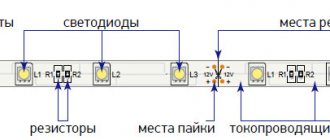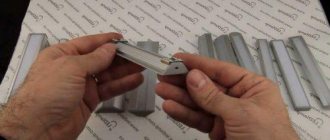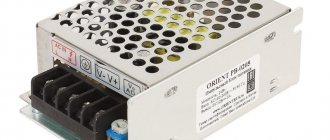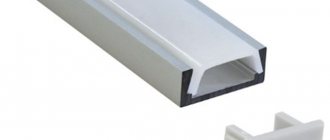The installation of the bandage tape is carried out using special tensioning machines.
Many electricians simply call them “meat grinder” or “helicopter”. The first copies of the cars were only imported. They do not cost very little - over 8,000 rubles. For example, Ensto - CT42.
Today, this tool is widely produced by domestic manufacturers (KVT company). In stores you can already find copies that are 2 times cheaper than foreign ones.
The main thing to remember is that the quality of fastening and tension of the bandage tape primarily depends not on the quality and manufacturer of the machine, but on the bandage tape itself and the fasteners used.
Differences and comparison
How does the INT-20 mini differ from other bandage machines?
For example, the classic IN-20 model, which is popularly called a “meat grinder,” has a total length of almost 30 cm. When tensioning the belt, this tool uses a handle to transmit torque to the lead screw.
For some, working with such a tool may not seem very convenient, since you have to constantly monitor the tension process.
Plus, its large dimensions do not add any advantages to it when installed at the height of supports. However, habit and a relatively low price determine the choice of IN-20 for many.
It is also worth noting that the advantage of the “meat grinder” is the possibility of such installation, when there is no excess waste or unnecessary pieces left from the bandage tape, which are then thrown away. How to do this, read the article “Installation of SIP bandage tape”
KVT also has a more modern model - INTu-20. There is much less discomfort when working here. Dimensions are smaller than those of the IN-20 bandage machine.
Its total length is 240mm.
The tension of the tape and tie is produced by translational movements of the upper handle. In this case, the steel strip itself is located almost horizontally to the surface on which the installation is carried out.
The mini model bandage machine has overall dimensions of only 170mm. Thanks to this, the tool can be used at height even with one hand.
The procedure for using a machine for tightening steel tape
The steel strip itself can be quite sharp at the edges, so when working with it, always wear gloves to avoid cutting yourself. First you need to prepare a bandage tape of the required length. To do this, wrap the tape around the support, add 5 cm from the edge to install the clamp, and about another 10 cm to install the tape itself into the tool. After this, the tape can be cut using a knife built into the stretching machine itself.
Then install the clamp so that the antennae point outward. Measure 5cm and bend the end towards the main section of the tape. Using pliers or a hammer, press it as close as possible to the back of the bracket.
Thread the ribbon through the hook and, leaning it against the support, make a turn around it.
This is also stated in the technological map for the installation of SIP wires from Ensto (download). Pay attention to this initially when you first select the length. After turning, insert the end of the tape into the slot of the fastener again and first manually tighten it, taking out as much slack as possible. Unscrew the handle on the machine so that the clamping part rests against the cutting
Then turn it with the slit facing up. Thread the free end of the tape inside the slot of the machine and clamp it with the locking handle. After which you can tighten the tie by tightening the tension mechanism as much as possible.
After turning, insert the end of the tape into the slot of the fastener again and first manually tighten it, taking out as much slack as possible. Unscrew the handle on the machine so that the clamping part rests against the cutting part. Then turn it with the slit facing up. Thread the free end of the tape inside the slot of the machine and clamp it with the locking handle. After which you can tighten the tie by tightening the tension mechanism as much as possible.
After the required tension has been achieved, bend the machine along with the tape towards the fastener ears and use a knife to cut it. Beat the remaining tail with a hammer and bend the antennae with it.
There is no need to stuff the clamp ears with the body of the bandage machine. If you use it like this, it won't last long.
Instructions for using the tool
- Cut the steel strip to the required length (add 15 cm to the size of the support’s coverage for securing it in the mechanism and installing fasteners).
- Put on the clamp.
- Insert the steel tape into the lock between the teeth, the tip should extend 2 cm from the lock.
- Bend the metal and press it tightly to the lock.
- Encircle the support, insert the second end of the segment into the lock, and tighten the loop tightly.
- Insert the remaining end into the slots of the clamping mechanism and clamp it with a lever.
- Rotate the tightening screw handle clockwise, gradually tightening the metal strip with maximum force.
- Carefully turn the machine around its axis so that the bandage bends 150°.
- Pull back the knife lever and cut off the metal.
- Close the lock by bending the tabs with hammer blows.
Bandage tape
It is best to choose a tape that is packaged in 50m rolls and packaged in convenient plastic cassettes with a handle. With this packaging, you will not have problems with it getting tangled or unwinding the required footage.
If you still purchased it in a paper package, then it is better not to tear the whole box, but to make a cut on top through which you can pass the end of the tape. The coil itself will remain securely twisted and will not get tangled either during transportation or when working with it.
Factory bandage tape has the following characteristics:
- tape width 20mm - for standard use; or 10mm - for small-section self-supporting insulated wires, or small-sized products on supports (for example, video cameras)
- tape thickness - from 0.4mm to 1mm (for SIP wires 0.7mm is most often used)
- maximum load - more than 9 kN for 0.7 mm tape; more than 5kN for 0.4mm tape
- material: stainless steel
Bandage tape is a universal fastening method for all types of supports:
- wooden round shape
- metal round, rectangular or hexagonal shape
- reinforced concrete round, rectangular, hexagonal
- sometimes you can even find such a miracle mount
Even on a d-40mm pipe you can fix anything you want with it. The main condition for this is that the surface of the fastening plane must be wider than the fastener itself. Otherwise, it may become deformed when tightened, and this will affect the quality of installation and its durability.
What can be secured with bandage tape in addition to fittings for SIP wires:
distribution cabinets and metering cabinets
- lamps
- road signs
- street cameras
- cable bundles
- insulation on heating pipes
- mesh grouse for fence posts
First of all, when choosing a tape, you need to look at the breaking load indicator. Moreover, it is not always necessary to choose a tape with its maximum value. Sometimes, depending on installation conditions, it is more advisable to use a lightweight version. This will be discussed in more detail below.
Tools for tying small and round loads with plastic tape
Tensioner for packaging tape Ergo 450 M and R-268, due to their design, can produce tension on plastic tape on a round and small-sized surface. The tape is secured using a self-tightening buckle.
Tensioner ERGO 450M
The packaging tool performs the following functions: tensioning and cutting the tape.
The machine provides high-quality tension and fastening of the tape on a round and small-sized surface.
The tensioner is used when packing cargo, when connecting plastic tape, using polypropylene, polyamide and steel buckles.
The ERGO 450M tensioner is used for fastening thermal insulation on pipes using polypropylene and polyester tape, as well as a galvanized wire buckle. The tool makes it possible to pull the insulation to the pipe without violating its integrity. The galvanized buckle and plastic tape will last a long time without replacement.
Specifications:
Type of tape: polypropylene and polyester;
Tape width - up to 28 mm;
Tape thickness - up to 1.0 mm;
Force max. — 250 kg;
Weight - 1.6 kg.
Tensioner YBICO P268
The packaging tool performs the following functions: tensioning and cutting the tape.
The machine provides high-quality tension and fastening of the tape on a round and small-sized surface.
The tensioner is used when packing cargo, when connecting plastic tape, using polypropylene, polyamide and steel buckles.
The tensioner is used to fasten thermal insulation to pipes using polypropylene and polyester tape, as well as a galvanized wire buckle. The tool makes it possible to pull the insulation to the pipe without violating its integrity. The galvanized buckle and plastic tape will last a long time without replacement.
Specifications:
Type of tape: polypropylene and polyester;
Tape width - 9-25 mm;
Tape thickness - 0.35-1.2 mm;
Force max. — 250 kg;
Weight - 1.5 kg.
Packing process with tensioners ERGO 450M and YBICO P278
- Tie the ribbon around the load, make a loop, and insert it into the buckle and tighten it
- a loop is made on the tape coming from the reel and tucked into the other side of the buckle (the tape that needs to be cut should be on top)
- insert the tape into the tool, with the spout (1) resting against the buckle, and the tape from the reel passed through the spout, then through the knife (2), and through the tension roller (3)
- handle 5 tensions the tape
- Squeeze handles 5 and 4 together and cut off the tape.
Instructions for using the tool for round weights, see everything very simply
related products:
- polypropylene packaging tape
- polyester tape
- composite tape
- ab tape
- unwinders (dispensers) for tape
- protective plastic corners
- protective cardboard corners
- buckles and staples
- cotton gloves
Bandage tape tensioner IN-20 and similar.
Let's start the review with the standard tensioner. What does it consist of?
First, there is the frame or housing in which the cutter knife is built.
Next comes a threaded rod with a mechanism for clamping the steel strip. If you take this clamping mechanism apart, you can see a spring inside.
It regulates the pressing force, allowing the handle not to bend.
On top is what is why this machine is actually nicknamed “helicopter” or “meat grinder” - a handle that transmits torque.
On high-quality models, there is a thick washer between the frame and the rotating rocker, which allows you to easily loosen and unscrew the handle back when the steel band is fully tightened.
Without it, the mechanism may “bite”.
Also pay attention to the fact that there is a restrictive ring at the end of the pin. If you get too worked up and suddenly start spinning the rocker back, it will simply unscrew from the pin and fall
If you get too worked up and suddenly start to spin the rocker back, it will simply unscrew from the pin and fall.
On earth this is a small problem. What if you are at the top of a support?
Everything here is fraught with the loss of precious time, and it is not known on whose head this detail may fall. If you don't have such a limiter, make one yourself.
There is nothing complicated about making it. Drill through the end of the pin and insert a steel ring into it, like on a bunch of keys.
There are different types available, differing in both width and thickness. So, some machines do not clamp thin bandage tape, but are designed to work only with thick ones.
The clamping mechanism in them can fit very tightly, or just a little short. Visually this is sometimes not even noticeable.
Therefore, when purchasing, always check the clamp, as they say in kind.
Its backlash also plays a significant role. For some products it is very small, and in other versions, the pressure head generally rotates freely around the pin.
Otherwise, before you thread the bandage tape, you will have to spend a long time trying to find the right position. Which you will agree is not entirely convenient.
The durability of the pin on which the “helicopter” runs is determined by the quality of the metal itself.
You’re unlikely to be able to check it in a store, but with Chinese products, after a few extra-strong tightenings, the thread is simply eaten away and rolled up.
But that’s not so bad. At one point, it may happen that the machine bites and does not follow the thread.
This is where normal work with her ends.
The next important part is the cutter. With frequent use, it certainly becomes dull.
Still, cutting a steel strip is not quite the same as biting copper or aluminum wires.
But this matter is solvable and can easily be sharpened back. The main nuance is the fastening.
It is secured with a screw and a curved handle with special recesses or grooves.
During operation, this screw tends to unwind. Accordingly, the handle and the cutter itself fall out.
If this happened somewhere in thick grass under a support, then it is not a fact that you will find this screw.
Therefore, before each climb up, check how securely the screw is tightened.
The location of the knife in low-quality models can also significantly complicate work. For example, in the photo below, everything is in order with the knife.
Even at the lowest dropped position of the handle, there is a wide gap for the entry of a steel strip.
But with this example, before inserting the tape inside, the handle will have to be bent upward each time, since the cutter itself covers part of the slot. And this is again a waste of time.
Pay attention to all these seemingly insignificant points, directly in the store, when choosing and purchasing a tensioner
Characteristics and design
The width of the widest tape that can be pulled together by machine is 20mm. Maximum thickness - 1mm. This is suitable for LKS, LKS-P brand tapes.
Cable ties that can be tightened using INT-20 mini are the SKS and SKS-P series with a width of 7.9mm and 12mm.
The design of the model is very simple and reliable. It includes:
ratchet mechanism
guide device
cutting knife. It is located inside the guide device.
tension axis
movable and fixed handles. They are coated with a non-slip coating.
knife handle. Cutting occurs when this handle is released.
In order for the tool to work for a long time, the moving parts of the ratchet mechanism must be periodically lubricated with grease or lithol.
You should also avoid getting small particles such as sand or dirt into the structure.
Summary table of approximate tool prices
| Brand | With ratchet mechanism | Cost in rubles |
| BANDIMEX 001 | No | 6100 – 6800 |
| BANDIMEX 400 | Yes | 7200 – 7800 |
| Sicame | Yes | 7500 – 10500 |
| ElectroHouse | No | 4800 – 7100 |
| INSL-1 | No | 8300 – 10300 |
| BANDIMEX W402 JUMBO | No | 5000 – 5600 |
machine for bandage tape.
| Machine for fastening SIP tape |
| High-quality bracket fastening into SIP fittings, knowledge came with experience. As convenient as possible... |
| Tags: |
| Mounting on a support bandage tape Telenco Sb207 20* 0.7mm economy |
| Click to view | This video shows how to properly mount the tape on a support. In this material it is used for… |
| Tags: |
| Ratchet Bandage Tool |
| TOOL FOR TENSIONING AND CUTTING STEEL TAPE WITH RATCHET MECHANISM.In this issue we will compare various... |
| Tags: |
| Selecting a machine for installing SIP tape. Ratchet vs meat grinder. SHTOK, SNR, Bandimex, KVT, iEK. |
| Tool for tensioning steel tape on supports KVT INT-20 mini |
| How to make your own machine for tightening steel bands. |
| Tags: |
| Mini review of the machine for bandage tape on SIP |
| Click to view | Profile pipe 40x40x2.0 Round fittings 10mm Nuts. |
| Tags: |
| Homemade tool for tensioning steel bands |
| Bandage tape machine, correct use when mounting on a support. Bandage tape, tools… |
| Tags: |
| Homemade steel belt tensioning tool |
| TOOL FOR TENSIONING AND CUTTING STEEL TAPE WITH RATCHET MECHANISM.In this issue we will compare various... |
| Tags: |
| Bandage tape machine - tensioning the tape on a pole |
| The fastest tool for installing SIP wire. KW, SHTOK, SNR, Bandimex, Telenco |
| Everything is made from improvised means using welding, a grinder and a drill. It was easier to buy, but still difficult... |
| Tags: |
| Installation of SIP: installation of a hook, work with bandage tape (refilling) |
| Click to view | I made a tool analogue to IN 20 (meat grinder) that is simple and reliable, and most importantly it will not break and is almost free... |
| Tags: |
| Homemade tool for tensioning bandage tape and sip tape |
| Click to view | A hand tool designed for tying products with metal tape. The tool is functional... |
| Tags: |
| Homemade metal band tensioner, analogue IN 20 |
| Click to view | It was not possible to buy a bandage tape tensioner. On the day I needed it, I wasn’t there... |
| Tags: |
| DIY bandage tape tensioner. |
| Demonstration of the process of tying a load with polypropylene tape onto a buckle using a separate set... |
| Tags: |
| MUL-20 Combined device for tensioning, fastening and cutting metal strips |
| . |
| Tags: |
| DIY bandage tape tensioner |
| Click to view | I don’t recommend the plastic shield to anyone, it leads when pulled, and when the lid is closed there is a gap. Everything comes from here... |
| Tags: |
| Stretching the bandage tape using a machine.” rel=»spf-prefetch |
| Description missing |
| Tags: |
| Manual tying of cargo with PP tape separate tool+buckle" rel="spf-prefetch |
| Click to view | Description missing |
| Tags: |
| Fastening with bandage tape» rel=»spf-prefetch |
| Click to view | Description missing |
| Tags: |
| Bandage tape. Do-it-yourself installation without special tools.” rel=»spf-prefetch |
Description of top models
Popular brands of bandage tightening mechanisms: Bandimex (Germany), Sicame (France), Insl-1 (China), ElectroHouse (China).
Model BANDIMEX W402 JUMBO - the tool works with steel tape up to 32 mm wide, using clamps, provides a tightening force of up to 2.5 tons.
BANDIMEX W001 is a universal device with a convenient design, reliability and durability. The steel strip is tightened with a force of one ton.
The Bandimex VC 400 tool with a ratcheting mechanism pulls a durable bandage tape with a force of up to 1 ton. The weight of the product is 2 kg.
Advantages of the machines:
- large selection of products by standard sizes;
- devices operate on supports of various diameters and cross-sectional shapes;
- ease of use;
- materials for manufacturing machine elements – stainless steel of the highest quality;
- all components are interchangeable;
- the products completely eliminate the use of bolts, nuts, and clamps;
- have an unlimited service life;
- The resulting fastenings cannot be dismantled.
When to use yoke and clamp
The yoke can withstand a load of 750-800 kg. If two strips of tape fastened with yokes wrap around a hook, then this is already 1.5 tons. The clamp holds a load of 600 kg or 1.2 tons per hook with double 0.7 mm tape.
You must clearly understand that any reinforcement must contain links of limited strength to protect the SIP line from mechanical damage. What does it mean?
Let’s say if a massive tree falls on a self-supporting insulated wire, then under no circumstances should the wire break, nor should a support collapse, which, in a domino effect, can take down its neighbors. According to the rules, links in linear reinforcement must be destroyed.
At the same time, not some of the most expensive and responsible ones, such as anchor clamps, but cheap parts of the product. Therefore, fastening the hooks with metal tape using clamps and yokes is the weak link.
Often, even designers make mistakes and use only yokes for fastening for all occasions, since they are the most universal and can be used both on intermediate and anchor supports. However, here the principle of universality can also play a negative role. Let's look at why this is so.
Let's say you have a SIP-1 wire with a load-bearing core cross-section of 70 mm2 and a destructive load of 2 tons.
It is secured with an anchor clamp that also has a force of 2 tons. And all this is mounted on a hook with two tapes and yokes that can withstand 1.5 tons.
During subsequent repairs, all that remains is to change two yokes and a piece of bandage tape. In terms of costs, these are mere pennies.
Where will your impulse first occur? Most likely on the wire. And the costs of eliminating the accident will be many times higher. Meanwhile, everything could be resolved at the installation stage by securing the tape not with yokes, but with clamps with a lower destructive load.
For SIPs with even smaller sections and compliance with the weak link condition, bandage tape of smaller thickness and width can be used. With appropriate clamps. All this must be taken into account and calculated at the design stage.
Flaws
The rule is widely known: the simpler the tool, the more reliable it is.
Although several useful functions have been added to the machine with a ratchet, in terms of reliability, it still loses to its not so sophisticated brother.
Here are a few disadvantages that you may encounter during long-term use of the machine if you come across a low-quality copy, no matter what manufacturer:
The eccentric teeth that press the tape become chipped over time. Because of this, you will have to bend the tape in the opposite direction and hold it to the pulling head. This is very inconvenient to do even on the ground, but imagine that you are hanging on a support?
The fixing screw of the knife handle may periodically become unscrewed after long-term use.
The machine requires constant care. The ratchet mechanism and moving parts require periodic lubrication with machine oil.
using the side knob as a hammer is also a very dubious advantage. Each blow will still be reflected on all moving elements. And this will not increase the service life.
Yoke and clamp - differences
Naturally, the tape itself cannot secure the hook or other equipment to the supports. This will require another additional element:
- yoke
- brace
In addition to appearance, the main difference between a yoke and a clamp is the following:
- The fastener is designed for fastening on intermediate supports where there are no frontal tensile loads
- the yoke is used on anchor supports, taking the entire tensile load of the SIP wire in the anchor span
You cannot use a yoke with a hole width of 20mm for a bandage tape 10mm wide. There must be a clear correspondence of the materials used.
Otherwise it will turn out like this.
It is no coincidence that staples have a special seam in their design. This is done so that, under critical loads, the fastener diverges along this seam and the SIP, together with the hook, falls down, preserving the integrity of both the SIP and the support.
Advantages of our products
You can order a tool for tensioning the bandage tape, the tape itself, clamps and many other materials from our company. We supply products for electrical installation and related work. We offer products from leading manufacturers at competitive prices with a quality guarantee. We invite you to familiarize yourself with the range of products and get advice from our specialist for help in choosing products. Additional bonuses are provided for regular customers, you can find out about them by contacting us.
Types of steel belt tensioning machines
There are also other models, for example, allowing you to do all the work with one hand. True, they cost almost twice as much. More information about prices can be found here.
Their handle can be rearranged from a straight position, when you need to use both hands, to an angular position - under one hand.
Or these examples from the company Shtok:
Well, and just for the exotic – these are battery-powered cars costing more than $1,000.
Of course, they tighten the tape automatically, but their locking mechanism is completely different.
Ordinary yokes will no longer work here. This tool is more for packaging work than electrical installation.











